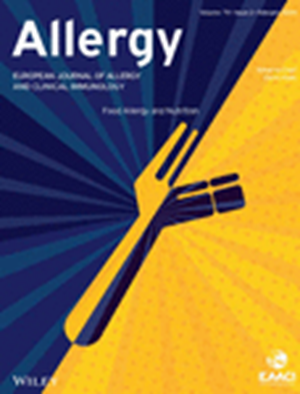药物引起的眼周和眼表疾病:EAACI立场文件。
IF 12
1区 医学
Q1 ALLERGY
引用次数: 0
摘要
各种全身和局部药物可引起眼和眼周皮肤不良反应(ae),从轻微到严重不等。这些ae可能导致眼表(OS)损伤,在某些情况下,还可能导致危及生命的并发症。药物性眼部不良反应主要分为毒性反应和/或过敏性超敏反应两大类,可由IgE介导,也可由非IgE介导。全身性抗生素、抗病毒药物和抗惊厥药可引发可能涉及OS的不良反应。抗组胺药、受体阻滞剂、抗精神病药、抗抑郁药和异维甲酸等药物与干眼症有关。局部治疗——包括抗生素、抗青光眼药物、防腐剂、隐形眼镜护理液和化妆品——可能引发过敏性或中毒性眼部疾病。最近的证据表明,在接受肿瘤疾病和特应性皮炎生物治疗的患者中存在眼表ae。用于治疗几种癌症的表皮生长因子受体抑制剂与结膜炎、睑板炎、干眼、眼周皮肤变化和毛状脱发有关。同样,首个被批准用于治疗中重度特应性皮炎的生物制剂dupilumab也与OS疾病合并眼睑结膜炎有关。本文结合最新文献和临床指南,对药物性眼部不良反应的临床表现、诊断方法和治疗策略进行了全面的综述。本文章由计算机程序翻译,如有差异,请以英文原文为准。
Drug-Induced Periocular and Ocular Surface Disorders: An EAACI Position Paper.
Various systemic and topical medications can induce ocular and periocular cutaneous adverse effects (AEs), ranging from mild to severe. These AEs may lead to ocular surface (OS) damage and, in some cases, life-threatening complications. Drug-induced ocular adverse reactions are generally classified into two primary categories: toxic reactions and/or allergic hypersensitivity reactions, which can be IgE or non-IgE-mediated. Systemic antibiotics, antivirals, and anticonvulsants can trigger adverse reactions that may involve the OS. Drugs like antihistamines, beta-blockers, antipsychotics, antidepressants, and isotretinoin are linked to dry eye disease. Topical treatments-including antibiotics, antiglaucoma medications, preservatives, contact lens solutions, and cosmetics-may elicit allergic or toxic ocular diseases. Recent evidence implicates ocular surface AEs in patients undergoing biological treatments for oncological diseases and atopic dermatitis. Epidermal growth factor receptor inhibitors, used in the treatment of several cancers, have been associated with conjunctivitis, meibomitis, dry eye, periocular skin changes, and trichomegaly. Similarly, dupilumab, the first biologic approved for treating moderate-to-severe atopic dermatitis, has also been linked to OS disease with blepharoconjunctivitis. This position paper provides a comprehensive overview of the clinical presentations, diagnostic approaches, and treatment strategies for drug-induced ocular AEs, integrating the latest literature and clinical guidelines.
求助全文
通过发布文献求助,成功后即可免费获取论文全文。
去求助
来源期刊

Allergy
医学-过敏
CiteScore
26.10
自引率
9.70%
发文量
393
审稿时长
2 months
期刊介绍:
Allergy is an international and multidisciplinary journal that aims to advance, impact, and communicate all aspects of the discipline of Allergy/Immunology. It publishes original articles, reviews, position papers, guidelines, editorials, news and commentaries, letters to the editors, and correspondences. The journal accepts articles based on their scientific merit and quality.
Allergy seeks to maintain contact between basic and clinical Allergy/Immunology and encourages contributions from contributors and readers from all countries. In addition to its publication, Allergy also provides abstracting and indexing information. Some of the databases that include Allergy abstracts are Abstracts on Hygiene & Communicable Disease, Academic Search Alumni Edition, AgBiotech News & Information, AGRICOLA Database, Biological Abstracts, PubMed Dietary Supplement Subset, and Global Health, among others.
 求助内容:
求助内容: 应助结果提醒方式:
应助结果提醒方式:


